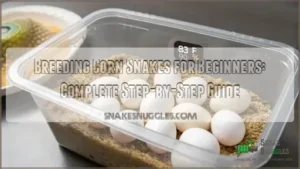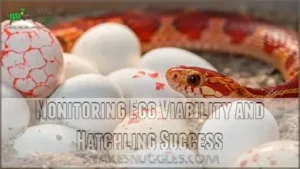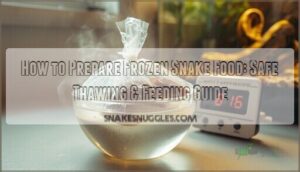This site is supported by our readers. We may earn a commission, at no cost to you, if you purchase through links.

You’ll need to simulate winter conditions through brumation, gradually cooling temperatures to 50-55°F for 8-12 weeks.
After warming them back up, introduce males to females during spring months.
Gravid females lay 10-30 eggs after 60 days, which require careful incubation at 82-84°F with proper humidity.
Success isn’t guaranteed on your first try, but patience pays off, and it’s essential to remember that each step matters, timing is everything, and the smallest details can make or break your breeding season.
Table Of Contents
- Key Takeaways
- Choosing Healthy Snakes
- Preparing Snakes for Breeding
- Brumation Process
- Mating Corn Snakes
- Caring for Gravid Females
- Incubating Corn Snake Eggs
- Raising Corn Snake Hatchlings
- Common Breeding Challenges
- Post-Mating Care
- Breeding Best Practices
- Frequently Asked Questions (FAQs)
- What is the Best Way to Sex a Corn Snake?
- How Often Should I Feed Adult Corn Snakes?
- Are There Any Special Incubation Requirements for Corn Snake Eggs?
- How Do I Know When Corn Snakes Are Ready to Mate?
- Are corn snakes easy to breed?
- How long does it take to breed corn snakes?
- What time of year do corn snakes lay eggs?
- How many times can you breed a corn snake?
- Is it easy to breed corn snakes?
- Are corn snakes good for beginners?
- Conclusion
Key Takeaways
- You’ll need healthy, mature corn snakes (2+ years old, 300+ grams) and must simulate winter through brumation—cooling them to 50-55°F for 8-12 weeks to trigger their natural breeding instincts.
- After brumation, introduce males to females during spring months, then carefully incubate the 10-30 eggs at 82-84°F with proper humidity for about 8 weeks until they hatch.
- You can’t skip steps or rush the process—timing matters for every phase from pre-breeding conditioning and brumation to egg incubation, and small details like temperature fluctuations can ruin your entire breeding season.
- Success isn’t guaranteed on your first attempt, so start with detailed record-keeping, avoid inbreeding by tracking genetics, and be prepared for challenges like health issues, egg failures, and the year-long commitment required for each breeding cycle.
Choosing Healthy Snakes
You’ll need to select corn snakes that are free from disease, parasites, and genetic defects before starting your breeding program.
Healthy breeding stock is the cornerstone of every successful corn snake breeding program.
Choose sexually mature snakes with ideal body weight, clear breeding history, and no visible abnormalities to guarantee successful reproduction and healthy offspring, ensuring they are free from disease.
Selecting Snakes Free From Disease
You’ll want to start your corn snake breeding journey by selecting disease-free snakes.
Look for visible symptoms like mites, respiratory infections, or unusual behavior patterns.
Establish quarantine protocols for new snakes, keeping them separate for 30-60 days.
Schedule veterinary exams and parasite screening to catch hidden health issues.
Healthy snakes are your foundation for successful breeding outcomes.
Understanding Genetic Considerations
Corn snake genetics determine your breeding outcomes.
Understanding recessive genes helps predict which morphs you’ll create.
DNA passes traits from parents to offspring through dominant and incompletely dominant patterns.
Genetic testing prevents inbreeding while maintaining healthy bloodlines.
Plan your genetic goals before breeding.
Lineage tracking guarantees you know each snake’s background, helping you produce desired corn snake morphs successfully.
Ideal Breeding Age for Corn Snakes
Age matters more than you might think when selecting breeding pairs. Sexual maturity doesn’t guarantee breeding readiness – your snakes need proper development first.
Here’s when corn snake breeding for beginners should start:
- Males reach sexual maturity at 18-24 months but breed best at 2+ years
- Females need 2-3 years minimum before their first clutch for ideal health
- Peak breeding lifespan spans 8-12 years with consistent clutch sizes
Age vs. health determines genetic impact on offspring.
Preparing Snakes for Breeding
You’ll need to condition your corn snakes for several months before breeding season to guarantee their bodies can handle the physical demands of reproduction.
This preparation involves increasing their feeding schedule, optimizing their environment, and monitoring their weight to confirm they’re in peak breeding condition.
Increasing Feeding Frequency and Nutrition
Before breeding season, you’ll need to amp up your corn snakes’ feeding schedules.
Feed adults every 7-10 days instead of the usual 14-21 days, focusing on proper nutrition and gut loading prey with vitamin D3.
This extra feeding builds fat reserves essential for successful reproduction.
Well-fed females produce healthier clutches, while males maintain stamina throughout the breeding process.
Adjusting Environmental Conditions
Beyond proper nutrition, you’ll need to fine-tune your snakes’ habitat for corn snake breeding success.
Adjust temperature gradients to 75-85°F with seasonal variation mimicking natural cycles. Maintain humidity levels around 50-60% and establish consistent lighting schedules.
Provide adequate enclosure size allowing movement and thermoregulation. These environmental conditions trigger reproductive hormones, preparing your breeding corn snakes for the upcoming brumation period.
Consider using aspen shavings as ideal substrate options for superior moisture retention.
Monitoring Weight and Body Condition
Throughout your breeding corn snakes journey, you’ll need to track weight fluctuations and body condition scoring carefully.
A healthy female should weigh at least 300 grams before breeding.
Monitor feeding schedule impact on weight gain, noting hydration level effects during shedding cycle weight changes.
Using a detailed feeding record helps track these changes.
Document weekly measurements to guarantee your snakes maintain ideal condition for successful reproduction.
Brumation Process
You’ll need to simulate winter conditions for your corn snakes through a process called brumation, which triggers their natural breeding instincts.
This cooling period lasts 60-75 days and requires you to gradually reduce temperatures to 55-60°F while monitoring your snakes’ health throughout the process.
Importance of Brumation in Breeding Cycle
Brumation basically flips the switch that awakens your corn snake’s breeding instincts.
Brumation is nature’s alarm clock for corn snake romance.
This cooling period triggers vital hormonal changes that directly impact fertility and breeding success rates.
Here’s what brumation accomplishes for breeding corn snakes:
- Hormonal Triggers – Activates reproductive hormones in both males and females
- Natural Instincts – Mimics wild seasonal cycles that corn snakes evolved with
- Fertility Impact – Increases egg viability and sperm production substantially
- Success Rates – Dramatically improves breeding cycle outcomes compared to non-brumated pairs
Gradual Temperature and Light Reduction
Start reducing temperatures and light exposure in early December for proper brumation timing.
Lower your corn snake’s habitat from 75°F to 55-60°F over two weeks, creating a natural temperature gradient. Simultaneously decrease the photoperiod from 12 hours to complete darkness.
These gradual changes simulate seasonal conditions, triggering hormonal shifts needed for breeding corn snakes. Accurate monitoring requires a reptile temperature device.
Environmental conditioning prevents shock while preparing reproductive cycles, ensuring a smooth transition for the snakes, and this process is crucial for successful breeding.
Monitoring Health During Brumation
Keeping watch over your corn snake’s wellbeing during brumation requires daily attention to subtle changes.
You’ll want to check for warning signs that could derail your breeding plans. Proper environmental conditioning during this cooler period sets the foundation for successful corn snake breeding later.
Reptiles in brumation experience a natural physiological process similar to hibernation. natural physiological process
- Weight Loss: Weigh your snake weekly; excessive weight loss beyond 10% indicates health problems requiring immediate veterinary attention
- Hydration Levels: Check skin elasticity by gently pinching neck skin; slow return suggests dehydration needing fresh water provision
- Respiratory Infections: Watch for mouth breathing, wheezing, or mucus around nostrils during temperature fluctuations throughout brumation duration
- Shedding Issues: Monitor for stuck shed or abnormal shedding patterns that signal improper humidity or underlying health concerns
Mating Corn Snakes
After your corn snakes complete brumation, you’ll introduce the male to the female’s enclosure to initiate mating behavior.
You’ll need to monitor their interactions carefully and adjust environmental conditions like humidity to encourage successful breeding.
Introducing Male and Female Corn Snakes
After brumation ends, place the male into the female’s enclosure for the initial introduction.
Watch for mating cues like the male’s persistent following and tongue-flicking behavior. Always supervise interaction to prevent aggression or stress.
Remove male after successful copulation occurs, typically within 24-48 hours.
Post-introduction care involves monitoring both snakes for injuries and providing separate recovery spaces for ideal corn snake breeding success.
Stimulating Reproductive Behavior
Temperature and photoperiod changes trigger your corn snakes’ reproductive instincts.
After brumation, males detect female pheromones that signal breeding readiness.
Here’s how to enhance reproductive behavior:
- Increase humidity to 70-80% for better pheromone detection
- Maintain temperatures at 78-82°F during daylight hours
- Provide 12-14 hours of light daily
- Allow males three days rest between mating attempts
- Monitor female receptivity through behavioral changes.
Ensuring proper temperature cycling is also essential for stimulating breeding behavior.
Recognizing Successful Mating
During successful corn snake breeding, you’ll observe distinct locking behavior where snakes intertwine for several hours.
After copulation, check for sperm plugs near the female’s vent—waxy white deposits confirming mating occurred.
Watch for female swelling in her posterior third and refusal feeding behavior. Monitor shed timing, as gravid females often shed before egg-laying during postmating development.
Caring for Gravid Females
Gravid females require specific care to guarantee healthy egg development and successful reproduction.
You’ll need to monitor their nutritional needs, adjust environmental conditions, and watch for pregnancy signs during the critical 4-6 week period between mating and egg-laying.
Signs of Pregnancy in Female Corn Snakes
After successful mating, you’ll notice several telltale signs that your female corn snake is carrying eggs.
Weight gain becomes noticeable within weeks, while appetite changes signal hormonal shifts. Behavior shifts include increased restlessness and seeking darker hiding spots.
Key indicators of gravid females include:
- Abdominal swelling that develops gradually over 4-6 weeks
- Pre-lay shed occurring 1-2 weeks before egg laying
- Palpation signs revealing firm, oval shapes when gently examined
- Nesting behavior like exploring potential laying sites constantly
Nutritional Requirements for Gravid Females
Once you’ve confirmed pregnancy, gravid females need extra nutrition for healthy egg development.
Feed them more frequently than usual, offering appropriately-sized prey that’s no wider than 1.5 times their body width.
Supplement occasionally with calcium and vitamins to prevent nutritional deficiencies, and make certain fresh water is always available for ideal weight gain, as proper hydration becomes critical now.
Providing Optimal Environmental Conditions
Your gravid female needs a carefully controlled environment to thrive during pregnancy.
Creating the right conditions supports healthy egg development and reduces stress.
Here are five key environmental factors for breeding corn snakes:
- Temperature gradients – Maintain basking spots at 85°F with cool sides at 75°F
- Humidity control – Keep levels between 50-60% using water bowls and substrate choices
- Lighting schedules – Provide 12-hour day/night cycles with UVB optional
- Enclosure size – Upgrade to 40-gallon minimum for comfortable movement
- Substrate choices – Use cypress mulch or aspen for easy cleaning
Incubating Corn Snake Eggs
Once your female corn snake lays her eggs, you’ll need to carefully transfer them to an incubator within 24 hours to maintain their original position.
Proper incubation requires consistent temperature between 78-80°F and humidity levels of 75-80% for approximately eight weeks until hatching occurs.
Proper Handling and Collection of Eggs
Handle corn snake eggs like precious cargo – they’re more fragile than they appear.
When collecting eggs after egglaying, maintain their original orientation and avoid rotating them.
Egg orientation matters because developing embryos attach to shell membranes.
Gently transfer eggs to your prepared incubation media using clean hands or tweezers.
Check for soft, yellowing shells indicating infertile eggs, and practice egg handling safety throughout, ensuring you handle them like fragile items.
Incubation Substrate and Temperature Control
Your incubation medium sets the foundation for corn snake breeding success.
Mix vermiculite or perlite with water until it feels like a wrung-out sponge for ideal substrate moisture. You can find vermiculite incubation products online.
Set your thermostat calibration at 81-83°F and avoid temperature fluctuations that harm developing embryos.
Proper incubation temperature and humidity control in your incubator directly impacts hatch rate and healthy development.
Monitoring Egg Viability and Hatchling Success
Check your corn snake eggs weekly using candling to spot healthy development inside.
You’ll see blood vessels and growing embryos in viable eggs.
Dead eggs turn moldy or collapse.
Watch incubation humidity levels closely – eggs dent inward when too dry.
After hatching, monitor first shed success and prepare for post-hatchling feeding.
Healthy baby corn snakes emerge strong and alert, with a clear sign of healthy development.
Raising Corn Snake Hatchlings
After your corn snake eggs hatch, you’ll need to provide proper care to help the babies survive their first critical weeks.
You must set up individual enclosures, monitor their first shed, and establish feeding routines with appropriately sized prey.
Assisting Hatchlings During Emergence
Rarely do corn snake hatching situations require your intervention, but stuck hatchlings need gentle assistance.
If neonates struggle after 24 hours, carefully perform egg slitting with sterile scissors.
Monitor humidity concerns that prevent proper emergence.
Watch for umbilical issues where yolk sacs remain attached.
Most hatchlings emerge naturally before their first shed, requiring minimal hatchling care during this delicate corn snake hatching process.
Setting Up Hatchling Enclosures
Create individual homes for your baby corn snakes using small plastic containers or commercial racks. Enclosure size should accommodate a 12-inch snake comfortably.
Choose paper towels or cypress mulch as substrate choice for easy cleaning. Install heating options like heat tape or under-tank heaters maintaining 78-82°F.
Proper hatchling care also involves selecting safe substrate options like reptile carpet or aspen shavings.
Monitor humidity levels at 50-60% using a hygrometer for proper hatchling care.
First Feeding and Nutrition for Neonates
Baby corn snakes won’t eat immediately after hatching, waiting for their first shed within seven to ten days.
Once they’ve shed, offer appropriately-sized pinky mice every five days. The pinky size should match the hatchling’s thickest body section.
Provide gutloaded prey for ideal nutrition and maintain proper hydration with fresh water bowls for successful hatchling care.
Common Breeding Challenges
You’ll encounter several obstacles when breeding corn snakes, including health problems in your breeding animals, stress-related complications in pregnant females, and eggs that fail to develop properly.
These challenges require careful monitoring and quick action to protect your snakes’ health and guarantee successful reproduction.
Addressing Health Issues in Breeding Snakes
When breeding corn snakes, health complications can derail your entire project faster than you’d expect.
Vigilant monitoring and preventive care protect your investment and guarantee successful reproduction cycles.
- Parasite Prevention – Quarantine new snakes and conduct fecal examinations before introducing them to your breeding program
- Genetic Disorders – Avoid inbreeding to prevent weakened offspring and inherited deformities that compromise snake health
- Brumation Risks – Monitor weight loss and respiratory infections during cooling periods when snakes are most vulnerable
- Egg Binding – Watch for prolonged labor and prolapse issues in gravid females requiring immediate veterinary intervention
Managing Stress in Pregnant Females
During corn snake breeding, pregnant females need minimal disturbance to thrive. Reduce interaction frequency and avoid unnecessary handling techniques that create stress.
Provide enclosure enrichment like secure hiding spots and maintain consistent temperatures.
Make dietary adjustments by offering appropriately sized prey every two weeks.
Watch for recognizing distress signs including defensive posturing, reduced appetite, or excessive movement patterns, which can indicate the need for minimal disturbance and a proper environment with secure hiding spots.
Dealing With Unfertilized or Dead Eggs
Egg-candling reveals the harsh reality of breeding setbacks.
Identifying infertile eggs early prevents contamination from potential bacteria that threatens healthy clutches.
Dead eggs appear opaque with dark spots, while fertile ones show blood vessels.
Remove failed eggs immediately using sterile tweezers.
Common causes include temperature fluctuations, poor genetics, or inexperienced females.
Proper incubation troubleshooting prevents future egg loss.
Post-Mating Care
After your corn snakes complete mating, you’ll need to separate them and focus on their individual health and nutrition needs.
Both the male and female require careful monitoring for stress, weight changes, and potential health complications during this critical recovery period.
Providing Proper Housing and Nutrition
After the stress of breeding, your corn snakes need ideal conditions to recover properly.
Proper housing and nutrition directly impact their long-term health and future breeding success.
Focus on these essential post-mating care elements:
- Enclosure Size – Provide spacious breeding enclosure with adequate room for movement
- Heating Methods – Maintain consistent temperatures using reliable heat sources
- Feeding Schedule – Resume regular corn snake diet with appropriate intervals
- Water Access – Guarantee fresh water availability for proper hydration
Prioritizing Snake Health
Health comes first in corn snake breeding success.
Maintain quarantine protocols for new snakes and establish husbandry standards that prevent disease.
Genetic screening helps avoid hereditary problems, while parasite prevention keeps your breeding stock strong.
Proactive vetcare catches issues early, protecting your investment.
When snake health stays priority number one, breeding for beginners becomes much more manageable and rewarding, thanks to good husbandry standards.
Monitoring for Health Issues
After mating, your snakes need watchful eyes like a hawk watching its nest.
Regular health checks prevent small problems from becoming big headaches in corn snake breeding.
Key health monitoring priorities:
- Parasite Prevention – Check for mites, ticks, and internal parasites through fecal exams
- Scale Rot and Respiratory Infections – Watch for wheezing, mouth rot, or belly discoloration
- Shedding Problems and Injury Assessment – Monitor stuck shed and breeding-related wounds
Breeding Best Practices
Following proper breeding practices guarantees you’ll produce healthy offspring while maintaining strong bloodlines.
You’ll need to avoid inbreeding, confirm market demand for your hatchlings, and keep detailed records of each breeding pair’s genetics and outcomes, which helps in maintaining healthy offspring and strong genetics.
Avoiding Inbreeding and Crossbreeding
After establishing proper post-mating care routines, you’ll need to plan future breeding decisions carefully.
Genetic diversity protects your corn snakes from mutation risks that come with poor lineage tracking.
Inbreeding between siblings or parents creates health problems, while crossbreeding different species produces sterile offspring.
Ethical breeding requires pedigree analysis to maintain breeding diversity.
| Breeding Practice | Genetic Impact | Health Outcome |
|---|---|---|
| Brother-Sister Mating | High inbreeding coefficient | Increased deformities |
| Parent-Offspring Pairing | Severe genetic bottleneck | Reduced fertility |
| Unrelated Snake Breeding | Maximum genetic diversity | Healthiest offspring |
| Multi-Generation Inbreeding | Accumulated mutations | Poor survival rates |
The table highlights the genetic impact and health outcomes of different breeding practices, emphasizing the importance of genetic diversity and the risks associated with inbreeding and poor lineage tracking.
Ethical breeding practices are crucial for the health and well-being of corn snakes.
Ensuring Market Demand for Offspring
Before diving into corn snake breeding, research current morph popularity and demand trends.
Understanding marketability prevents you from producing unwanted offspring that burden rescue organizations.
Consider these ethical factors:
- Breeder reputation suffers when flooding markets with common morphs
- Niche markets reward unique genetic combinations over mass production
- Responsible sales guarantee proper homes for every hatchling you produce.
Popular corn snake morphs command higher prices than standard varieties.
Documenting The Breeding Process
Keep detailed records of your corn snake breeding journey from start to finish.
Document mating dates, egg-laying schedules, and incubation temperatures in a breeding checklist.
Take photos of parents and offspring to track genetic lineage patterns.
Record feeding schedules, growth rates, and any health issues.
This data collection helps you make future improvements and becomes invaluable for your snake breeding guide.
Frequently Asked Questions (FAQs)
What is the Best Way to Sex a Corn Snake?
Like cracking nature’s code, you’ll probe gently near the tail’s base using a lubricated probe or examining tail length.
Males have longer, thicker tails with hemipenal bulges, while females show shorter, thinner tails tapering quickly, which can be key to distinguishing between the sexes.
How Often Should I Feed Adult Corn Snakes?
Adult corn snakes should eat every 7-14 days, depending on their size and age.
Younger adults need weekly feeding, while older snakes can go two weeks between meals.
Monitor their body condition closely.
Are There Any Special Incubation Requirements for Corn Snake Eggs?
Imagine this: your corn snake eggs are precious treasures requiring precise care.
You’ll need consistent temperatures at 78-80°F, humidity levels of 75-80%, and proper ventilation during the critical 8-week incubation period for successful hatching.
How Do I Know When Corn Snakes Are Ready to Mate?
You’ll know corn snakes are ready to mate after successful brumation when males become more active, females show receptive behavior, and both display increased appetite.
Watch for courtship behaviors like tongue-flicking and body positioning during introductions.
Are corn snakes easy to breed?
Breeding corn snakes resembles nurturing a garden—with patience and proper preparation, you’ll find success blooms naturally.
These resilient serpents adapt well to captive breeding when you provide consistent temperatures, humidity, and brumation cycles for reproductive triggers, which is crucial for their breeding process, and with proper care, they thrive.
How long does it take to breed corn snakes?
You’ll need about one full year to complete corn snake breeding.
This includes three months of brumation, followed by mating, then eight weeks for egg incubation, plus time for hatchling care.
What time of year do corn snakes lay eggs?
Like clockwork in nature’s calendar, your corn snakes will lay their precious cargo in late spring.
You’ll typically see eggs appearing between mid-May and early June, roughly 4-6 weeks after successful mating occurs.
How many times can you breed a corn snake?
You can breed a healthy female corn snake annually throughout her reproductive lifespan, which typically spans 10-15 years.
However, giving her every other year off helps maintain peak health and egg quality.
Is it easy to breed corn snakes?
You’ll find corn snake breeding moderately challenging, not exactly "easy." Success requires careful planning, proper equipment, and patience for the year-long process including brumation, mating, incubation, and hatchling care.
Are corn snakes good for beginners?
Corn snakes are like the golden retrievers of the reptile world—gentle, forgiving, and perfect for first-time snake owners. They’re hardy, rarely bite, eat readily, and tolerate handling mistakes beautifully.
Conclusion
Sarah’s first breeding attempt failed when she skipped brumation, thinking her snakes would mate without it.
After following proper cooling protocols the next season, she successfully hatched twelve healthy babies.
Breeding corn snakes for beginners requires patience, attention to detail, and strict adherence to each step.
You’ll face challenges, but success comes from understanding your snakes’ natural cycles, maintaining proper conditions, and learning from mistakes.
Start with healthy adults and follow this guide systematically.
- https://www.icr.org/article/snake-hybridization-intrabaraminic-diversity/
- https://arav.org/
- https://my.clevelandclinic.org/health/diagnostics/25210-stool-test
- https://www.cdc.gov/nutrition/infantandtoddlernutrition/breastfeeding/how-much-and-how-often.html
- https://www.allaboutcornsnakes.com/breeding_brumation_pairings.html








